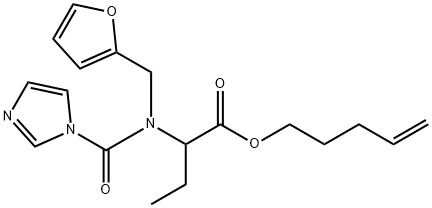Pefurazoate is used to control seed-borne fungal diseases, particularly
Fusuriurn monuliniforme (Bakanae disease), Pyriculuriu ovyzae (rice
blast) and Cuchliobolus rniyubeunus (brown spot) on rice plants. It also
controls rice seedling blight caused by soil-borne pathogens (Trichoderme
viride and Fusurium spp.) in nursery box cultivation, and other fungal
pathogens on seeds of wheat, barley and flower bulbs.
ChEBI: Pent-4-en-1-yl 2-[(2-furylmethyl)(imidazol-1-ylcarbonyl)amino]butanoate is a carboxylic ester obtained by formal condensation of the carboxy group of 2-[(2-furylmethyl)(imidazol-1-ylcarbonyl)amino]butanoic acid with the hydroxy group of pent-4-en-1-ol. It is a N-acylimidazole, a member of furans, a carboxylic ester and an olefinic compound.
This rice fungicide has been introduced by Showa Denko for the treatment of rice seedlings in Japan. It is based on a racemic homoalanine pentenyl ester backbone.
Moderately toxic by ingestion, inhalation, and skin contact routes. Experimental reproductive effects.
Pefurazoate is readily degraded in soils, plants and mammals and the
molecule is susceptible to attack by enzymes at several sites. Metabolic
cleavage of the molecule gives simpler fragments formed by loss of the
imidazole ring.
Pefurazoate is stable in acidic media and slightly unstable in alkaline
media. It is stable to sunlight and decomposes only to the extent of about
1% after 90 days at 40 °C.
